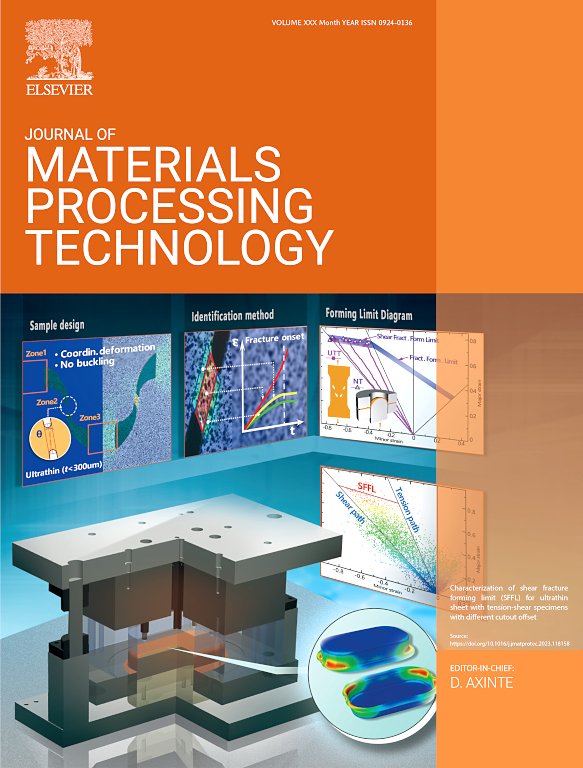通过控制水冷条件调整激光沉积镍铝青铜合金的微观结构演化
IF 6.7
2区 材料科学
Q1 ENGINEERING, INDUSTRIAL
Journal of Materials Processing Technology
Pub Date : 2024-11-12
DOI:10.1016/j.jmatprotec.2024.118659
引用次数: 0
摘要
受镍铝青铜(NAB)水下原位修复应用需求的启发,研究提出水冷条件是否有利于在修复过程中形成合适的冷却速率,以防止粗大κ相的形成。通过数值模拟初步验证了水下修复的适当冷却速率。然后采用陆上激光直接金属沉积(DMD)和水下激光直接金属沉积(UDMD)技术对 NAB 基底上的梯形凹槽进行修复。实验结果表明,UDMD 过程中的快速冷却会产生独特的微观结构。与 DMD 修复样品相比,层间热影响区的宽度和纳米κⅡ相的平均尺寸都减小了,在任何修复样品中都没有观察到κⅣ沉淀。一个有趣的发现是,κⅢ相在基体中分散析出。两个拉伸试样都在基体区而不是修复区失效。然而,沉积过程中基体上的热暴露会导致κⅡ相在热影响区轻微增长。与铸造基底相比,通过 DMD 和 UDMD 修复的样品的拉伸强度降低了约 7%。这项研究证明了对大型铜合金部件进行原位水下修复的可行性,同时也为在合金制造过程中通过外部环境条件控制微结构的演变提供了新的工艺参考。本文章由计算机程序翻译,如有差异,请以英文原文为准。
Tailoring microstructural evolution in laser deposited nickel-aluminum bronze alloy by controlling water cooling condition
Inspired by the application requirements of underwater in-situ repair of nickel-aluminum bronze (NAB), the study proposes whether the water-cooling conditions are conducive to forming an appropriate cooling rate during the repair process to prevent the formation of coarse κ phases. The appropriate cooling rates of underwater repair has been preliminarily verified through numerical simulation. Then onshore laser direct metal deposition (DMD) and underwater laser direct metal deposition (UDMD) technologies are employed to the repair of the trapezoidal grooves on NAB substrates. The experimental results show that the rapid cooling rates during UDMD result in a unique microstructure. Compared to DMD repaired samples, the width of the interlayer heat-affected zone and the average size of nano κⅡ phase are reduced, no κⅣ precipitates were observed in any of the repaired samples. An interesting finding is that the κⅢ phases are dispersively precipitated in the matrix. Both the tensile specimens fail in the substrate zone rather than the repaired zone. However, the thermal exposure on the substrate during deposition causes slight growth of the κⅡ phase in the heat-affected zone. The tensile strength of the samples repaired by DMD and UDMD is reduced by approximately 7 % compared to the cast substrate. This study proves the feasibility of in-situ underwater repair for large copper alloy components and can also provide new process references for controlling the evolution of microstructures through external environmental conditions during alloy manufacturing.
求助全文
通过发布文献求助,成功后即可免费获取论文全文。
去求助
来源期刊

Journal of Materials Processing Technology
工程技术-材料科学:综合
CiteScore
12.60
自引率
4.80%
发文量
403
审稿时长
29 days
期刊介绍:
The Journal of Materials Processing Technology covers the processing techniques used in manufacturing components from metals and other materials. The journal aims to publish full research papers of original, significant and rigorous work and so to contribute to increased production efficiency and improved component performance.
Areas of interest to the journal include:
• Casting, forming and machining
• Additive processing and joining technologies
• The evolution of material properties under the specific conditions met in manufacturing processes
• Surface engineering when it relates specifically to a manufacturing process
• Design and behavior of equipment and tools.
 求助内容:
求助内容: 应助结果提醒方式:
应助结果提醒方式:


